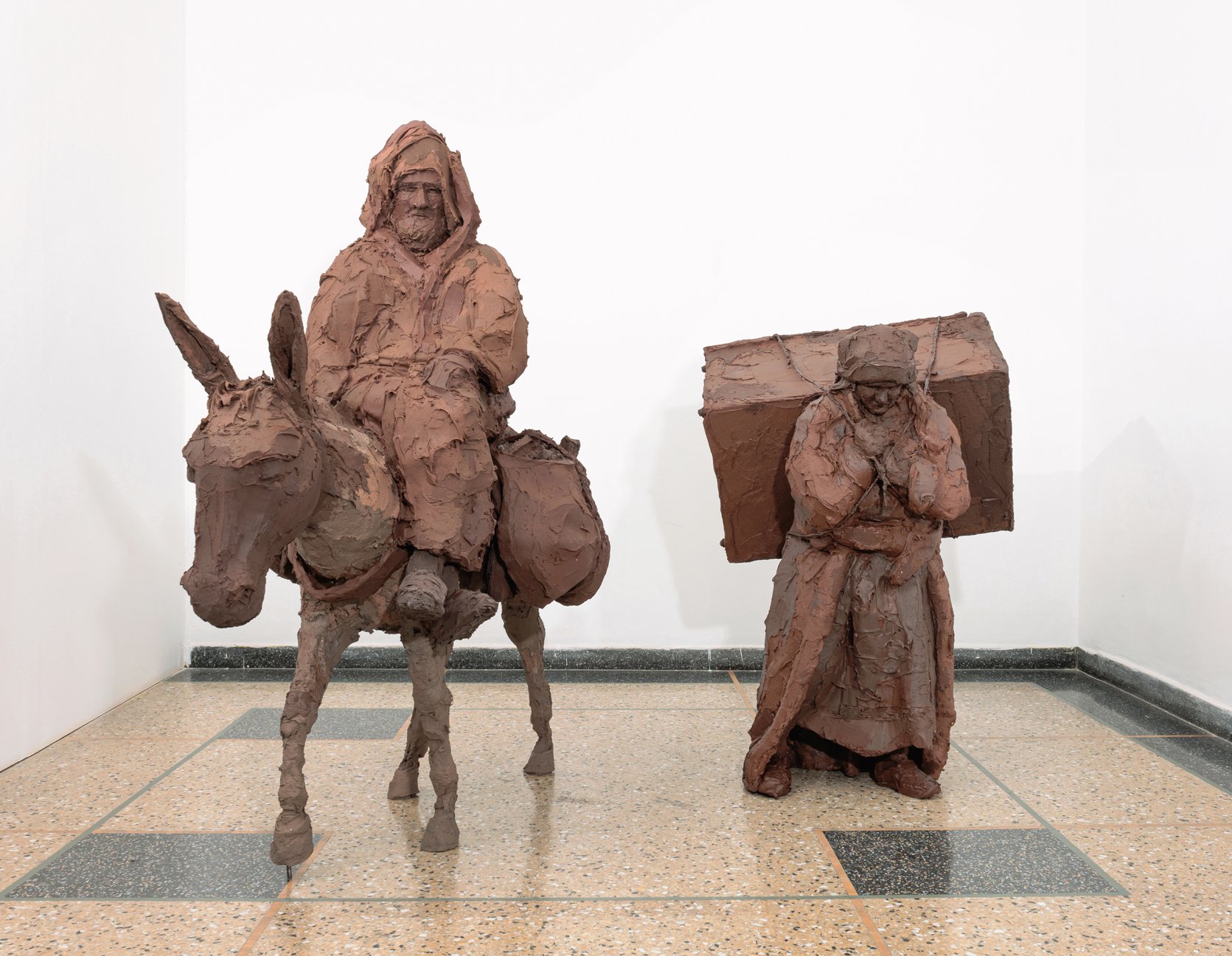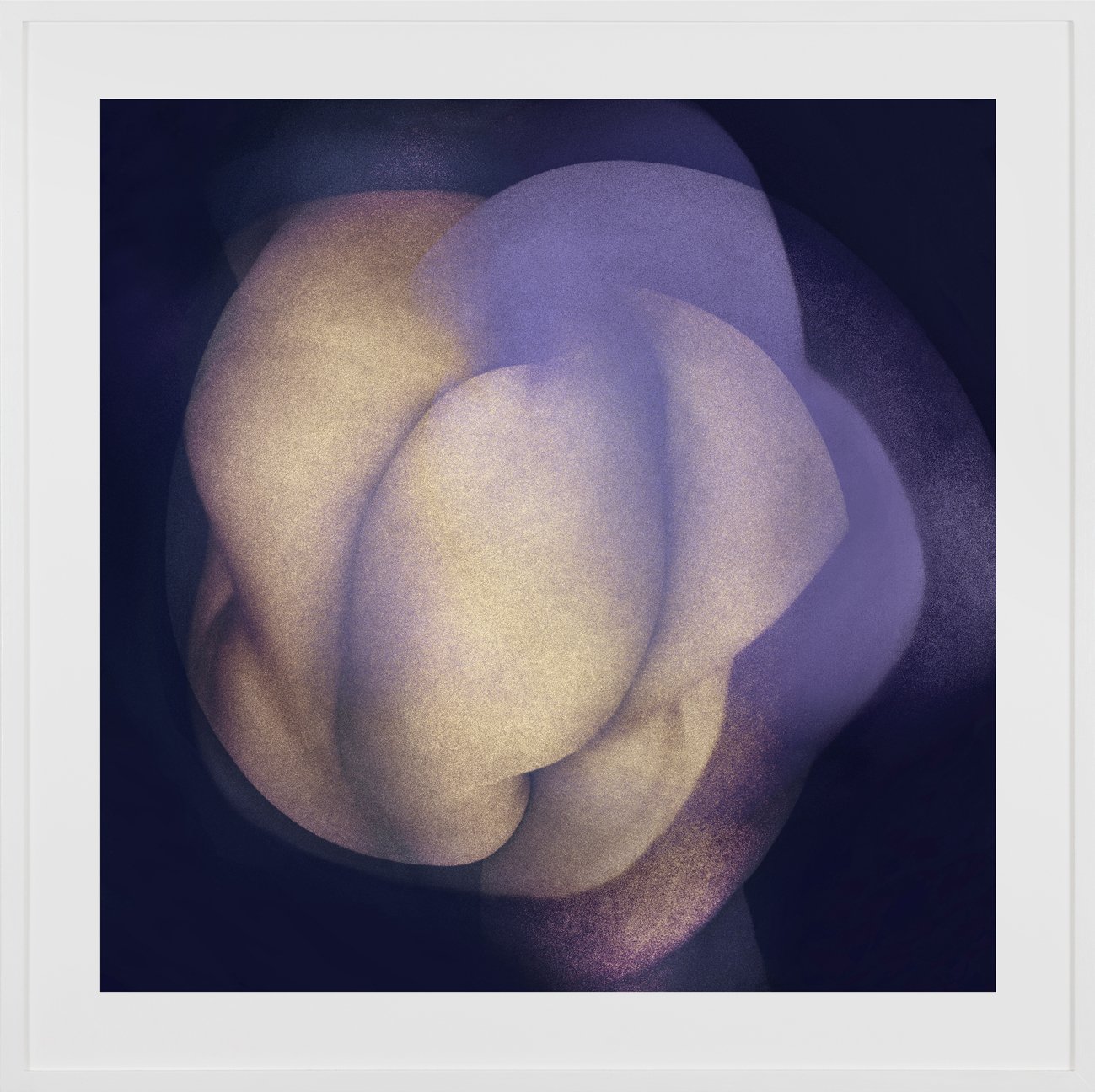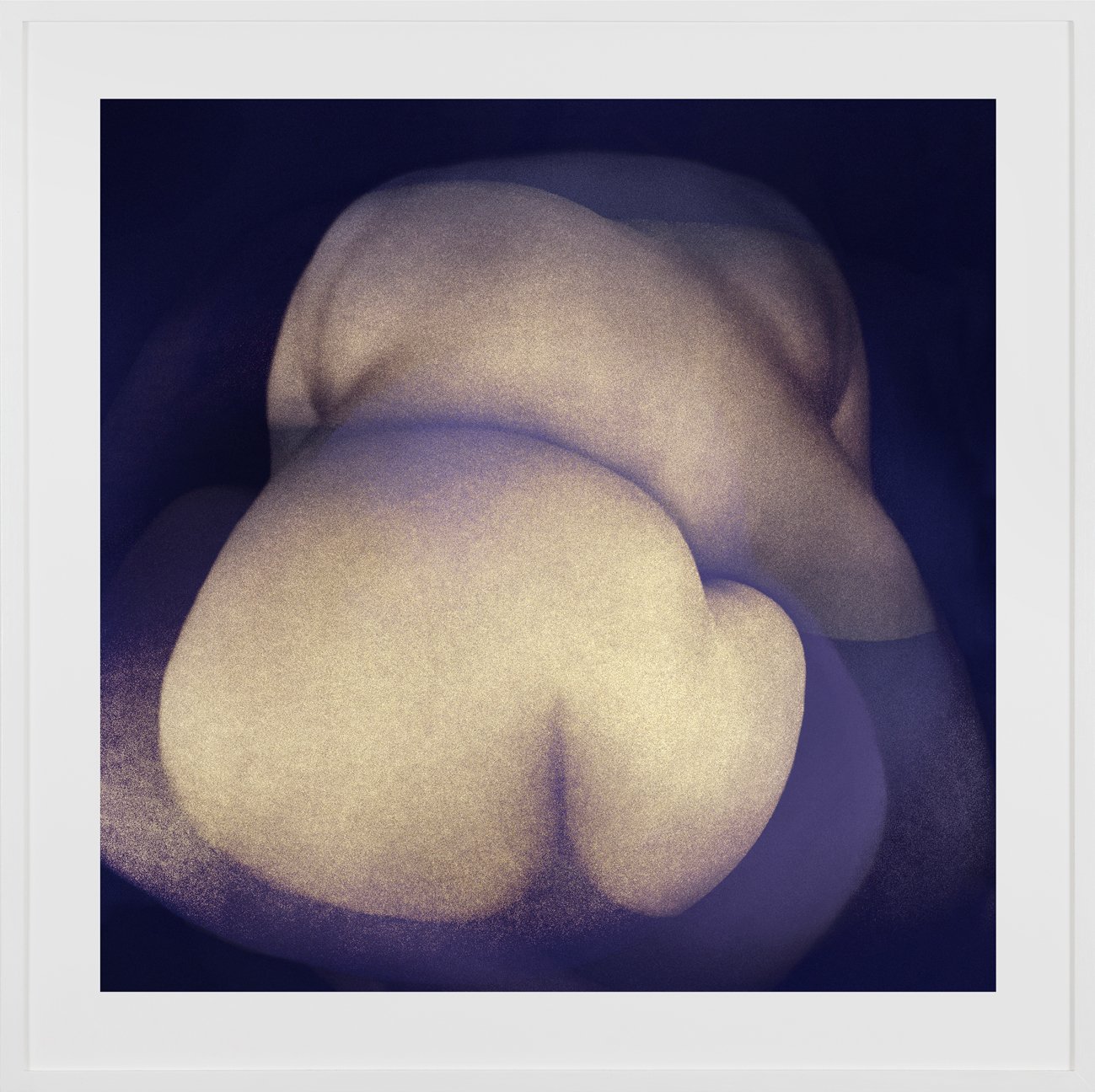Sans titre, 2022 - Sculpture en résine et cheveux - 40 x 20 x 15 cm
Yasmina ALAOUI, self-portraits containing her own hair. Having collected her shed hair over a period of time, Yasmina ALAOUI chose to embed it in resin. Thus, she voluntarily preserves her own DNA in a fashion akin to Nature safeguarding fragments of genetic material in natural amber since pre-historic times.
The practice of creating artwork by using hair goes back as far as ancient Egypt and reached its apogee in Victorian England. Hair wreaths, hair paintings and hair sculptures were usually fabricated with the hair from a beloved family member, but the Victorians also maintained a thriving trade in imported hair from strangers. Recently female artists such as Kiki Smith, Mona Hatoum, and Krystyna Piotrowska have used hair in their art to express personal takes on culture, displacement, and as symbols of the essence of femininity including its erotic connotations. Yasmina ALAOUI ‘s hair artwork bring up the collective engagement of women as the nurturing element in the development of humanity.
Fertilités I, 2022 - Technique mixte - sous-vêtements, acrylique & goudron sur toile de jute - 150 x 150 cm
Fertilités IV, 2022 - Technique mixte - sous-vêtements, acrylique & goudron sur toile - 100 x 100 cm
Fertilités II, 2022 - Technique mixte - sous-vêtements, acrylique & goudron sur toile - 100 x 100 cm
Fertilités III, 2022 - Technique mixte - sous-vêtements, acrylique & goudron sur toile - 100 x 100 cm
Fertilités V, 2022 - Technique mixte - sous-vêtements & acrylique sur toile - 100 x 100 cm
Ombres I, 2022 - Technique mixte, khôl & cendres sur bois - 118 x 90 cm
Ombres II, 2022 - Quadriptyque - Technique mixte, khôl & cendres sur bois - 236,5 x 268,5 cm
In her apparel paintings Yasmina ALAOUI interprets a superstitious practice played out during the moussem of Lebhirate, held yearly in the province of Safi. Here, single women participate in the unusual act of throwing their apparel onto the main street for the tribal leaders to drive over it in their vehicles. Subsequently the women wear this apparel in the hope of finding a worthy spouse, as popular belief wills that the passage of vehicles ignites the hope to find a soulmate. In a remarkable literal analysis, Yasmina ALAOUI soaked the apparel in tar before accumulating the pieces onto the canvas before painting the entire work black. In a less restricted interpretation Yasmina ALAOUI used the apparel as templates for spraying.
Min Dhakirati - (De ma mémoire), 2022 - Sculpture en résine
This sculpture recounts a more recent memory of attending the popular yearly three-day Imilchil Marriage Festival. Yasmina ALAOUI’s attention was caught by an ageing Amazigh couple who had just acquired a small fridge only to find her values of gender equality shaken when she saw the husband preparing to mount their mule, leaving his wife to walk with the small fridge strapped on her back. Knowing very well that in rural Amazigh society, women often bear the brunt of the physical work, Yasmina ALAOUI was astonished by her own conflicting gut reaction and decided to depict this survival of an ancestral socio-political notion when Amazigh men were warriors in local disputes or Royal military campaigns known as ‘harka’, making them absent from home for long periods of time. Thus, historically Amazigh women time and again took up the tasks which in Western culture were traditionally performed by men, such as labouring the land, herding the livestock, collecting firewood. The resulting sculpture aptly touches on the concepts of humanism and values in sociology.
In addition to the ancestral socio-political notion, the sculpture illustrates the cultural survival of the matriarchal organisation of traditional Amazigh society. It is accepted knowledge that during pre-Islamic times the Amazighen were Isis worshippers and that matrilineal descent has perpetuated through Tamazight, the Amazigh language, which channels cultural self-conception, family, home, intimacy, village affiliation and nostalgia to a remote past. As the custodians of language, Amazigh women remain the guardians of the Amazigh cultural identity. Thus, they effectively preserve attributes that are considered female in Moroccan culture.
Evidently Amazigh women are not ready to give up their status which originated in the intricate millennia-old fabric of their unique society. Despite the advance of modern society, it appears that Amazigh women are still proud to display their physical strength which historically refers to their essential role and power within the tribe.
To highlight this socio-historical and cultural survival in modern times, Yasmina ALAOUI fittingly chose to fashion the piece in resin mimicking the sketchy technique of clay modelling historically reserved for small-scale preliminary maquettes or ‘bozzetti’ and used on a larger scale by the French Impressionists. The result is nothing less than arresting, as the multiple shifting cultural connotations are echoed in the lively layers of matter which are applied with spontaneous freedom and accurate self-confidence alike.
Bénédictions II, 2022 - Technique mixte - bandeaux de plâtre & colle sur bois - 162 x 120 cm
Bénédictions III, 2022 - Technique mixte - bandeaux de plâtre & colle sur bois - 118 x 118 cm
Bénédictions I, 2022 - Technique mixte - bandeaux de plâtre & colle sur bois - 161,5 x 260 cm
FINGER CASTS
The highly original series of ‘Finger Casts’ communicates the level of illiteracy which continues to cripple the poorer socio-economic strata of Moroccan society. Yasmina ALAOUI invited into her studio eight illiterate women whose only option of survival is hard manual labour. As if she were medically tending to a fractured finger, Yasmina ALAOUI chose to use medical gauze and plaster for the casting. The time required to obtain the quantity of casts needed, gave these industrious hands some temporary respite from their heavy daily duties.
Arranged in a manner where each cast props up another, the ensemble becomes a metaphor for the way Moroccan women in agricultural society combine their efforts in harvesting the totality of their lands in the spirit of mutual support. On the one hand, these harmonious compositions mimic the daily teamwork of all hands working together to achieve the task in hand. On the other, Yasmina ALAOUI’s practice of using medical equipment to cast the fingers, as if she were nursing a gaping wound, solicits a debate about pain and calls for compassion towards those women involved. The conflicting duality of beauty and pain displayed in the juxtaposition of the strength of the industrious working hands of Moroccan women, and the broken fingers unequivocally transmits Yasmina ALAOUI’s own recent introspective journey.
Despite the compact design and the fatalistic thematic connotations, these contemporary assembled accumulations are imbued with a sense of weightlessness, which is typical of the artist’s ability to delicately play with the notion of ambivalence and transformation. They also confront the viewer with the dichotomy of the seemingly light poetic flow of the artwork and the intense physical labour of its creation. The dynamic movement of the swaying waves of fingers fittingly represents the constant flux of life.
Stylistically the series of ‘Finger Casts’ adheres to the ZERO movement. Founded in 1957 by German artists Heinz Mack (born 1931) and Otto Piene (1928- 2014), it proclaimed the end of traditional art making in an attempt to create a new radical beginning described by Piene as ‘a zone of silence and of pure possibilities for a new beginning’. Yasmina ALAOUI’s harmoniously undulating reliefs which were painstakingly created by sticking down each finger cast individually recall the rippled organic structures of spirals and fields made up of individual nails hammered into a panel by Gunther Uecker (born 1930).
Mémoires pétries, 2022 - Ensemble de 25 - Résine sur cadres en bois - 150 x 150 cm
BREADS
The series of coloured resin ‘Breads’ narrates an olfactory childhood memory when Yasmina ALAOUI happily partook in the traditional inter-generational way of living at her Moroccan family’s home in Fez. Yasmina ALAOUI fondly recalls children and adults constantly coming and going, whilst bathing in the human warmth of three generations preparing and sharing meals.
With ‘Breads’, Yasmina ALAOUI validates Moroccan women’s daily morning ritual of pressing the family’s marking into the dough before taking it to the communal oven. The millennia-old tradition of bread-making and marking has a history that ran parallel with the development of civilizations. Since Mesopotamian times, this apparently simple food has been intertwined with war and peace, famine and wealth, the sacred and the secular, thus turning it into a metaphor for human survival.
Stylistically the series of ‘Breads’ adheres to the art-historical movement of Dada and Marcel Duchamp’s pioneering practice of working with the found object. Duchamp (1887-1968) proclaimed that choosing an object with non-art functions in order to place it in an art context made the choice of object a creative act in itself. During the 1960s, the replication and transformation into another medium of the banal found object became one of the cornerstones of Pop Art.
Hiya - (elle), 2022 - Sculpture en résine - 166 x 88 x 72 cm - يَ هِ
HIYA
Standing strong in all her splendour, Yasmina ALAOUI’s Aïcha Kandicha appears as a defiant seductive nude beneath a burqa whilst gripping a sabre in her right hand. The burqa caresses the body and falls into a luscious drapery usually identified with the elegance of luxurious evening attire. As such it sits in stark contrast to the plain, heavy and loose-fitting uniform imposed onto women by Muslim rulers in certain Central Asian countries.
Yasmina ALAOUI’s radical choice to recreate the female jinn as a three-dimensional life-size sculpture dressed in a garment which is not Moroccan might sit uncomfortably at first sight. However, on further inspection it becomes human and richly metaphysical as a poignant meditation on personal freedoms. Yasmina ALAOUI deliberately unleashes within the viewer a multitude of incongruent sentiments about womanhood as advocated in traditional patriarchal societies, in the hope of opening a wider debate about feminism in general, and the social control of the female body in particular.
In Moroccan mythology and the Moroccan people’s collective folkloric memory Aïcha Kandicha survives in a multitude of interpretations and forms following regional storytelling. However, as a general rule Aïcha Kandicha is invested with a dual positive-negative existence: as the courageous benevolent and beautiful creature who saved Morocco from its invaders by drowning them or as the archetypal harlot appearing near water sources awaiting stray local men, to seduce them into madness or even into death. Aïcha Kandicha is typically described as an attractive young female woman with the hoofed legs of a goat or a camel.
The sculpture communicates Yasmina ALAOUI’s wish to underline the unbeatable inner resilience of women despite their plight of being weighed down by segregation and the restrictions in possessing their physical appearance which inevitably leads to a slavish mentality. For, it is a worldwide phenomenon that in macho societies, strong women invariably equal ambiguous identity and traditionally serve as the scapegoat for all misfortunes befalling society. In the wider sociological context of gender equality, the rebellious figure of Aïcha Kandicha stands for the individual struggle of every woman, whatever her cultural background, to remove the shackles of this judgement. Executed with consummate elegance the sculpture oscillates between gesture and stillness, which invests this figure of ambiguity with yet another level of contradiction.
Lecture opaque III, 2022 - Triptyque - Bas relief en résine sur bois peint - 132 x 277 cm
Lecture opaque II, 2022 - Bas relief en résine sur bois peint - 140 x 110 cm
Lecture opaque I, 2022 - Bas relief en résine sur bois peint - 140 x 110 cm
Lecture opaque V, 2022 - Bas relief sur résine - 69 x 58 cm
Lecture opaque VII, 2022 - Bas relief sur résine - 75 x 56 cm
Lecture opaque VI, 2022 - Bas relief sur résine - 114,5 x 74,5 cm
Lecture opaque IV, 2022 - Bas relief sur résine - 53,8 x 45 cm
Recently, Yasmina ALAOUI was fascinated by what she witnessed at Sidi Abderrahmane, a small islet off the Casablanca corniche which houses the shrine of the 19th Century marabout Sidi Abderrahmane, a native of Baghdad. This holy man was reputedly able to walk on water and reach inaccessible worlds. Today the islet of Sidi Abderrahmane is known for the ritual of ‘Ldoun’ in which female clairvoyants known in Morocco as ‘chouwafa’ ward off bad luck or read the future of an individual by analysing the shapes of molten lead taking shape whilst cooling off when poured into water.
Yasmina ALAOUI has recreated these poured shapes in resin and arranged them into organic formations onto impeccably polished resin slabs in rich colours, much in contrast to the commonplace dirt-beaten or cement floors of the dwellings in which the divination rituals take place. As such, these fortune-telling lead spills are transfigured into surprisingly light and elegant oriental compositions which are reminiscent of the startling Chinese representations of the dragon as an imperial symbol of great power, prosperity, and strength. These works reveal Yasmina ALAOUI’s ability to reformulate a known practice, in this case César Baldacini’s 1960s so-called expansions, and make it undeniably original.
Lumières I, 2022 - C-print sur papier aquarelle - 92,2 x 92,2 cm
Lumières II, 2022 - C-print sur papier aquarelle - 92,2 x 92,2 cm
Lumières VII, 2022 - C-print sur papier aquarelle - 92,2 x 92,2 cm
Lumières VI, 2022 - C-print sur papier aquarelle - 92,2 x 92,2 cm
Lumières IV, 2022 - C-print sur papier aquarelle - 92,2 x 92,2 cm
Lumières V, 2022 - C-print sur papier aquarelle - 92,2 x 92,2 cm
Lumières III, 2022 - C-print sur papier aquarelle - 92,2 x 92,2 cm
HAMMAM MEMORIES
Aged six, whilst visiting her paternal grandparents in Fes, Yasmina ALAOUI stood out as the exotic, foreign American-born French Moroccan.
Keen to initiate her granddaughter into the traditional hammam ritual, her paternal Moroccan grandmother unwittingly gave the child a bewildering experience. Whilst being led through the three rooms with increasing heat levels, Yasmina ALAOUI became confused at the abundant presence of opulent female nudity milling around in a confined space gossiping and laughing, whilst brazenly scrubbing each other. Shrouded in the semi-darkness of the hammam’s soft light, all the six-year-old child perceived and retained in her mind from this vivid sororal display were headless phantom-like bodies and singular body-parts.
In adulthood, Yasmina ALAOUI was able to bridge the divergent cultural taboos surrounding female nudity, which had struck such a dissonant chord early in life. Thus, the female nude has featured prominently in her work, first in the series ‘1001 Dreams’ (2003-2011) where she applied meticulously detailed Arabic Henna patterns onto photographs of graceful female nudes shot by her partner Marco GUERRA. Some years later another collaboration with Marco GUERRA resulted in ’Tales of Beauty’ (2012-2014) which addressed the subject of corpulent women in a particularly sculptural fashion manifested in fluid shapes intersected and folded back onto themselves. At the same time Yasmina ALAOUI used some of these images to create her first series of ‘Hammam Memories’ (2011-2013). Tightly framed and partly removed from a pure figurative context, these human shapes are transmuted into near abstract landscapes, in a fashion reminiscent of the nude perspectives of German-British photographer Bill Brandt (1904-1983), or even of the erotic imagery of American photographer Edward Weston (1886-1968).
In the present ‘Hammam Memories’, Yasmina ALAOUI has further reinterpreted the nude by arranging and layering the body parts into compositions that can be read as symbols of budding life, ranging from fruiting to flowering and foetal growths. These images operate as metaphors of the visual rebirth of her own memory.
By playing with focus, these delicate compositions seem to float within a transparent protective membrane which imbues them with a potent sense of inner stillness. Their execution bears testimony to Yasmina ALAOUI’s outstanding command of all technical aspects of photography and printing.




























